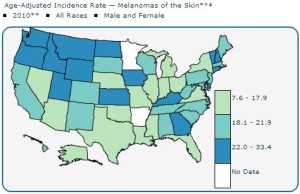As the weather warms up, the sunscreen gets slathered on to prevent sunburns and melanoma—a cancer of the skin resulting from UV damage to skin DNA. However, sunscreen alone can’t seal the safety deal—that’s where you come in. Sunscreen is like a decent wingman—while it can get you part of the way there, some things are in your hands and yours alone. Use these five tips to stay on your A-game this summer.
Embrace your inner vampire
Honestly, when it comes to sun damage prevention, abstinence is the best policy. Staying out of the sun, especially during prime sunshine hours (between 10 a.m. and 4 p.m.), is the best way to avoid UV damage to your skin.
Seek shade whenever possible, or bring your own. Umbrellas, broad-brimmed hats and high-coverage clothing are examples of bring-along shade that can keep you protected from direct rays.
Use protection
Shade-seeking is a good habit, but chances are you can’t stay in the dark forever. While sunscreens don’t make sun exposure 100 percent risk-free, they can still be your skin’s last defense against sunburns and the skin cancers they lead to.
Behave like a ginger
You probably know one of those people that burn instantly in the sun, or you might be one. These people lather up in sunscreen at every opportunity and do their best to limit their time under the rays.
These sun-sensitive souls know the power of staying out of the sun whenever possible and religiously reapplying sunscreen throughout the day to avoid it wearing off. Paranoia is their friend. Follow their example, and it can be your friend, too.
Pretend you’re naked
Often, sunscreen users forget that a little bottle of lotion does not make them invulnerable to the effects of direct sunlight. They don’t let high noon chase them out of the sun and stay exposed for longer periods of time with false faith in their skincare products.
Even with a solid layer of SPF 90+ sunscreen plastered on your skin, you are still at risk. Most sunscreens filter UVB rays from the sun, which are the rays that cause sunburns. However, UVA radiation can penetrate deeper into your skin and are not blocked by all sunscreens. Don’t be fooled into thinking you aren’t exposed to dangerous radiation.
Get the D
Studies comparing Americans in northern versus southern states (Center for Disease Control and Prevention) and indoor versus outdoor workers (Radespiel-Troger 2009) indicate that people with lower levels of vitamin D may be at increased risk of developing melanoma (Godar 2009 ), and it is known that vitamin D helps in fighting other forms of cancer (National Cancer Institute) .
So, while zeroing out sun exposure is a surefire way to avoid UV damage, limited sun exposure isn’t completely detrimental. Being in the sun enough to stock up on vitamin D or asking your doctor about vitamin D supplements can help reduce your risk of developing melanoma.

